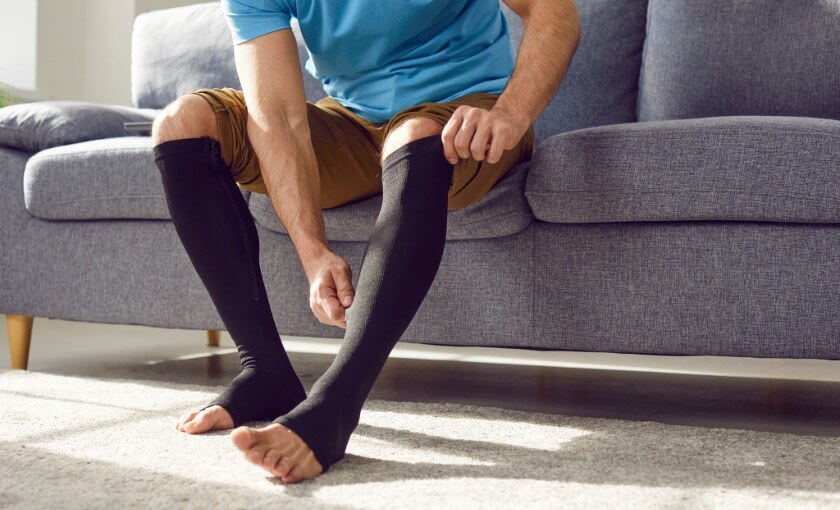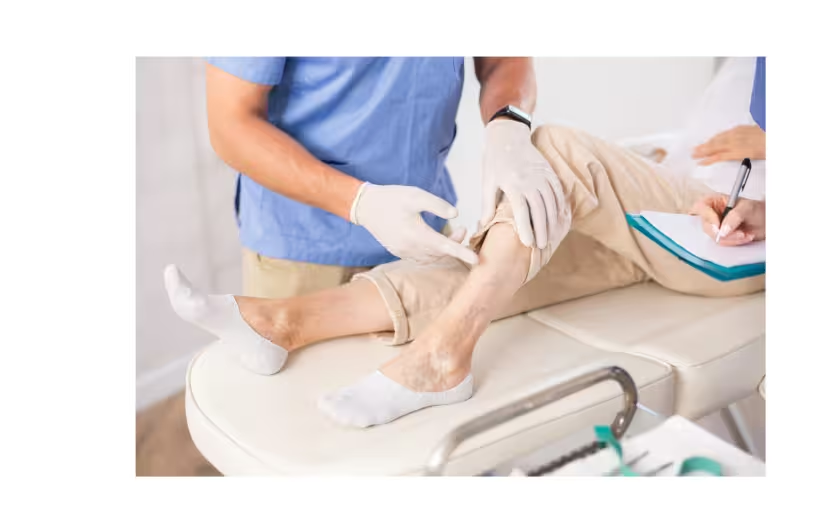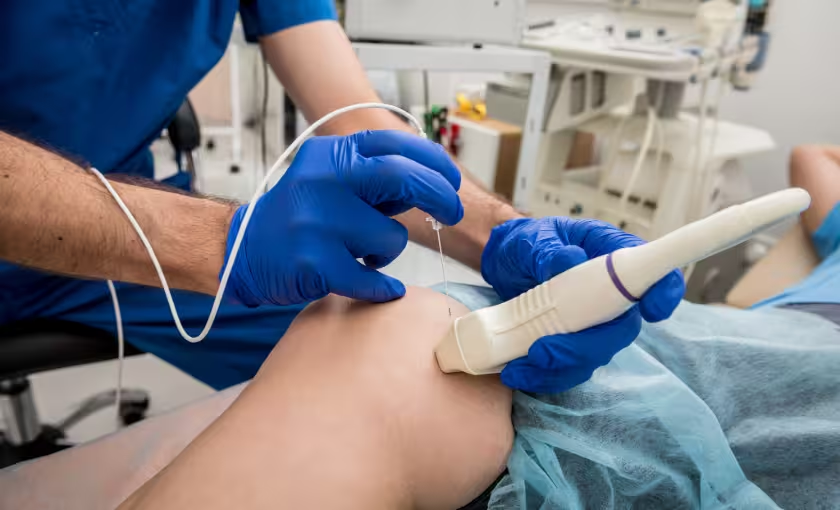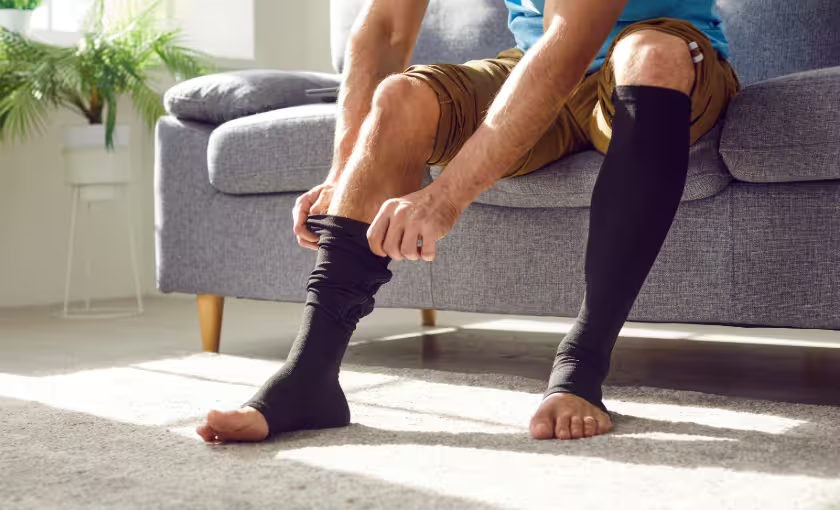Compression Therapy Guide: Your Complete Resource for Vein Support

Compression therapy represents one of the most effective, non-invasive treatments available for managing vein problems and supporting overall vascular health. Understanding how compression therapy works, when it's beneficial, and how to use it properly empowers individuals to take advantage of this valuable tool for maintaining healthier, more comfortable legs throughout their lives.
The science behind compression therapy is based on the principle of applying graduated external pressure to the legs, which helps counteract the effects of gravity, supports weakened venous valves, and improves the efficiency of blood return to the heart. This external support can provide significant benefits for people with existing vein problems while also serving as an effective preventive measure for those at risk of developing venous issues.
BASS Vein Center's extensive experience prescribing and fitting compression garments for patients with various types of vein problems has provided valuable insights into how to optimize the benefits of compression therapy while ensuring comfort and compliance. This expertise helps individuals understand how to select, use, and maintain compression garments for maximum therapeutic benefit.
Understanding Compression Therapy
Compression therapy works by applying controlled pressure to the legs in a graduated manner, with the highest pressure at the ankle gradually decreasing toward the knee or thigh. This graduated pressure pattern mimics and enhances the natural muscle pump mechanism that helps move blood through the venous system against gravity.
The physiological effects of compression therapy include improved venous return, reduced venous pressure, decreased swelling, and enhanced circulation throughout the lower extremities. These effects work together to provide both immediate symptom relief and long-term benefits for vein health and overall vascular function.
Graduated compression is essential for therapeutic effectiveness, as uniform pressure throughout the leg would not provide the same benefits and could potentially impede circulation. The graduated pressure pattern ensures that blood is encouraged to flow upward toward the heart rather than pooling in the lower extremities.
The mechanism of action involves external pressure that helps compress superficial veins, redirecting blood flow to deeper veins where it can be more efficiently returned to the heart. This redirection reduces the workload on superficial veins and can help prevent or slow the progression of venous insufficiency.
Immediate benefits of compression therapy can include reduced leg heaviness, decreased swelling, improved comfort during prolonged standing or sitting, and enhanced exercise tolerance. These immediate effects often provide motivation for continued use and compliance with compression therapy recommendations.
Long-term benefits may include slowed progression of existing vein problems, reduced risk of complications such as blood clots or skin changes, and improved overall quality of life for individuals with venous insufficiency or other circulation problems.
Types of Compression Garments
Understanding the different types of compression garments available helps individuals select the most appropriate option for their specific needs, lifestyle, and therapeutic goals. Each type of compression garment offers unique advantages and may be more suitable for different situations or conditions.
Compression stockings represent the most common type of compression garment and are available in various lengths, compression levels, and styles to meet different therapeutic needs and personal preferences. These stockings provide graduated compression from the ankle upward and can be worn daily for ongoing vein support.
Knee-high compression stockings are the most popular choice for many individuals, as they provide effective compression for the lower leg, where most vein problems occur while being easier to put on and more comfortable than longer options. These stockings are suitable for most types of vein problems and daily wear.
Thigh-high compression stockings provide compression coverage for the entire leg and may be recommended for individuals with vein problems that extend above the knee or for those who need more comprehensive support. These stockings can be more challenging to put on and keep in place but provide more complete coverage.
Compression pantyhose offer full-leg coverage similar to thigh-high stockings but with the added benefit of a waistband that helps keep the garment in place. These may be preferred by women who want comprehensive coverage and a more familiar garment style.
Compression socks designed for athletic use combine therapeutic compression with moisture-wicking materials and cushioning features that make them suitable for exercise and active lifestyles. These socks can provide vein health benefits while supporting athletic performance and recovery.
Maternity compression stockings are specially designed to accommodate the changing body shape during pregnancy while providing the graduated compression needed to prevent and manage pregnancy-related vein problems. These stockings often feature special panels or designs for comfort during pregnancy.
Compression Levels and Prescriptions
Compression garments are available in different pressure levels, measured in millimeters of mercury (mmHg), with higher numbers indicating greater compression. Understanding these compression levels helps ensure that individuals receive the appropriate level of support for their specific condition and needs.
Light compression (8-15 mmHg) provides gentle support that may be beneficial for individuals with mild symptoms, those who spend long periods standing or sitting, or for general prevention in people at risk for vein problems. This level of compression is available without prescription and can be purchased over-the-counter.
Moderate compression (15-20 mmHg) offers more significant support and is often recommended for individuals with mild to moderate vein problems, including small varicose veins, spider veins, or early symptoms of venous insufficiency. This level may also be recommended for prevention in high-risk individuals.
Medium compression (20-30 mmHg) provides substantial support and is typically recommended for individuals with moderate to severe vein problems, including larger varicose veins, significant symptoms, or a history of venous complications. This level usually requires professional fitting and may require a prescription.
High compression (30-40 mmHg) offers maximum support and is reserved for individuals with severe venous insufficiency, significant swelling, or a history of serious venous complications such as blood clots or venous ulcers. This level requires professional fitting and prescription from a healthcare provider.
Extra-high compression (40+ mmHg) is used only in special circumstances for individuals with severe venous disease or lymphatic problems and requires careful medical supervision and professional fitting. This level of compression is not appropriate for most individuals with routine vein problems.
Professional assessment is important for determining the appropriate compression level, as using too little compression may not provide adequate benefits while using too much compression can be uncomfortable and may cause problems if not properly fitted and monitored.
Proper Fitting and Selection
Proper fitting is crucial for the effectiveness and comfort of compression garments, as poorly fitted garments may not provide adequate therapeutic benefits and can cause discomfort or even harm if they're too tight or create pressure points.
Professional fitting by trained specialists ensures that compression garments provide the correct pressure distribution and fit properly for maximum therapeutic benefit and comfort. Many medical supply stores and vein clinics offer professional fitting services for compression garments.
Measurement timing is important for accurate fitting, as leg measurements can vary throughout the day due to swelling and other factors. Measurements are typically taken in the morning when swelling is minimal, or after legs have been elevated to reduce any existing swelling.
Key measurements for compression stockings include ankle circumference, calf circumference, and leg length, with additional measurements needed for thigh-high or pantyhose styles. These measurements are used to determine the correct size and ensure proper fit and compression distribution.
Fit assessment should include checking for proper compression at the ankle, smooth distribution of pressure up the leg, absence of bunching or rolling, and comfortable fit without excessive tightness or looseness. Proper fit ensures both effectiveness and comfort.
Comfort considerations include selecting appropriate materials, styles, and features that meet individual preferences and lifestyle needs while providing the necessary therapeutic benefits. Modern compression garments are available in many styles and materials to meet diverse needs and preferences.
Daily Use and Care Instructions
Proper use and care of compression garments is essential for maintaining their therapeutic effectiveness, ensuring comfort, and maximizing their lifespan. Understanding how to properly wear, care for, and maintain compression garments helps individuals get the most benefit from their investment in vein health.
Application techniques for compression stockings can be challenging initially, but proper technique makes the process easier and ensures that the garments provide optimal compression distribution. Using proper application techniques also helps prevent damage to the garments and ensures comfortable wear.
Putting on compression stockings is easiest when done in the morning before swelling develops, and the process can be made easier by using application aids such as stocking donners or rubber gloves for better grip. Taking time to apply stockings properly ensures better fit and comfort throughout the day.
Wearing schedule recommendations vary depending on the individual's condition and the compression level prescribed, but most people benefit from wearing compression garments during waking hours when they're upright and active. Some individuals may need to wear compression garments for specific activities or times of day.
Duration of wear typically involves putting on compression garments in the morning and wearing them throughout the day, removing them at bedtime unless specifically instructed otherwise by a healthcare provider. Consistent daily wear provides the most benefit for vein health and symptom management.
Removal techniques should be gentle to avoid damaging the garments and to prevent sudden changes in circulation that might cause discomfort. Gradual removal and gentle handling help maintain the integrity of the compression garments.
Care and maintenance of compression garments involves proper washing, drying, and storage to maintain their compression properties and extend their useful life. Following manufacturer care instructions helps ensure that garments continue to provide effective compression over time.
Benefits for Different Conditions
Compression therapy provides benefits for a wide range of vein-related conditions and symptoms, with the specific benefits varying depending on the individual's condition, the type of compression garment used, and the consistency of use.
Varicose veins can benefit significantly from compression therapy, which helps reduce the pressure within affected veins, decreases symptoms such as aching and heaviness, and may slow the progression of the condition. Compression therapy is often recommended as a first-line treatment for varicose veins.
The support provided by compression garments helps reduce the diameter of varicose veins and improves the efficiency of blood flow through the venous system, leading to reduced symptoms and improved comfort for individuals with these enlarged, twisted veins.
Spider veins may also benefit from compression therapy, particularly when they're associated with underlying venous insufficiency or when they cause symptoms such as burning or aching. Compression can help reduce the pressure that contributes to spider vein development.
Chronic venous insufficiency, a condition where the venous system fails to efficiently return blood to the heart, can be effectively managed with compression therapy, which helps compensate for the impaired function of venous valves and reduces symptoms.
Leg swelling from various causes can be reduced with compression therapy, which helps prevent fluid accumulation in the tissues and promotes the return of excess fluid to the circulation. This benefit can be particularly valuable for individuals who experience swelling due to prolonged standing or sitting.
Post-surgical recovery following vein treatments can be enhanced with compression therapy, which helps reduce swelling, supports healing, and may improve treatment outcomes. Many vein specialists recommend compression garments as part of post-treatment care protocols.
Compression Therapy for Prevention
Compression therapy can serve as an effective preventive measure for individuals at risk of developing vein problems, helping to maintain healthy circulation and reduce the likelihood of developing venous insufficiency or other vein-related conditions.
High-risk occupations that involve prolonged standing or sitting can benefit from preventive compression therapy, which helps counteract the effects of static positioning and maintains healthy circulation throughout the workday. Many healthcare workers, teachers, and other professionals use compression garments preventively.
Travel-related prevention is another important application of compression therapy, as long flights or car trips can increase the risk of blood clots and circulation problems. Compression stockings are commonly recommended for air travel and other situations involving prolonged immobility.
Pregnancy prevention involves using compression therapy to prevent or minimize the development of pregnancy-related vein problems, which are common due to hormonal changes, increased blood volume, and pressure from the growing uterus. Maternity compression stockings can provide significant benefits during pregnancy.
Athletic performance and recovery can be enhanced with compression garments designed for sports use, which may help improve circulation, reduce muscle fatigue, and speed recovery after exercise. Many athletes use compression garments both during and after physical activity.
Genetic predisposition to vein problems may warrant preventive use of compression therapy, particularly for individuals with strong family histories of varicose veins or other venous conditions. Early use of compression therapy may help delay or prevent the development of vein problems.
Age-related prevention becomes increasingly important as individuals get older and experience natural changes in their venous system that increase the risk of vein problems. Regular use of compression therapy can help maintain healthy circulation and prevent age-related venous issues.
Overcoming Common Challenges
Many individuals face challenges when beginning compression therapy, but understanding these common issues and their solutions helps ensure successful adoption and long-term compliance with compression therapy recommendations.
Difficulty putting on compression garments is one of the most common challenges, particularly for individuals with limited mobility, arthritis, or other conditions that affect dexterity. Various application aids and techniques can help overcome this challenge and make compression therapy more accessible.
Donning aids such as stocking donners, sock aids, and rubber gloves can significantly ease the process of putting on compression garments, making them accessible to individuals who might otherwise struggle with application. These aids are widely available and can make a significant difference in compliance.
Comfort concerns, including feelings of tightness, warmth, or skin irritation, can often be addressed through proper fitting, selection of appropriate materials, and gradual adaptation to wearing compression garments. Most comfort issues resolve as individuals become accustomed to wearing compression garments.
Skin care becomes important when wearing compression garments regularly, as proper hygiene and moisturizing can help prevent skin problems and ensure comfortable wear. Using appropriate lotions and maintaining good skin hygiene helps prevent irritation and other skin issues.
Lifestyle integration challenges can be addressed by selecting compression garments that meet individual lifestyle needs and preferences, including options for different activities, seasons, and clothing styles. Modern compression garments are available in many styles to meet diverse lifestyle needs.
Cost considerations may be a concern for some individuals, but many insurance plans cover compression garments when prescribed by healthcare providers for medical conditions. Understanding insurance coverage and exploring different options can help make compression therapy more affordable.
Special Considerations and Contraindications
While compression therapy is safe and beneficial for most individuals with vein problems, certain conditions and circumstances require special consideration or may contraindicate the use of compression garments.
Arterial disease, particularly peripheral arterial disease that affects blood flow to the legs, may contraindicate the use of compression therapy or require special monitoring and modified compression levels. Individuals with arterial problems should consult with healthcare providers before using compression garments.
Diabetes and other conditions that affect sensation in the legs require careful monitoring when using compression therapy, as reduced sensation may prevent individuals from recognizing if compression garments are too tight or causing problems.
Skin conditions such as dermatitis, open wounds, or infections may require special consideration when using compression therapy, as compression garments could potentially worsen these conditions or interfere with treatment.
Heart failure and other cardiac conditions may require modified approaches to compression therapy, as changes in circulation and fluid balance could affect how individuals respond to compression. Healthcare provider guidance is important for individuals with cardiac conditions.
Pregnancy considerations include selecting appropriate maternity compression garments and monitoring for any changes in comfort or circulation that might indicate the need for adjustments in compression therapy during pregnancy.
Age-related factors may affect the selection and use of compression garments, as older adults may have different needs, limitations, or health conditions that require special consideration when implementing compression therapy.
Combining Compression with Other Treatments
Compression therapy is often most effective when combined with other treatments and lifestyle modifications that support vein health and overall vascular wellness. Understanding how to integrate compression therapy with other approaches helps optimize outcomes.
Exercise and compression therapy work synergistically to improve circulation and support vein health, with compression garments often enhancing the benefits of physical activity while exercise helps maintain the muscle pump function that supports venous return.
Wearing compression garments during exercise can provide additional support for the venous system and may help reduce exercise-related symptoms in individuals with vein problems. Many athletic compression garments are designed specifically for use during physical activity.
Medical treatments for vein problems, including procedures such as sclerotherapy or endovenous ablation, are often combined with compression therapy to optimize outcomes and support healing. Post-treatment compression is a standard part of care for most vein procedures.
Lifestyle modifications such as weight management, dietary changes, and occupational adjustments can enhance the benefits of compression therapy and provide comprehensive support for vein health. A holistic approach that addresses multiple factors often provides the best outcomes.
Elevation and positioning strategies can be combined with compression therapy to provide additional benefits for circulation and symptom relief. Understanding how to optimize positioning while wearing compression garments helps maximize therapeutic benefits.
Professional monitoring and follow-up care help ensure that compression therapy continues to provide optimal benefits and that any adjustments needed over time are made appropriately. Regular assessment helps maintain the effectiveness of compression therapy.
Long-term Success and Compliance
Achieving long-term success with compression therapy requires understanding the factors that promote compliance and developing strategies to maintain consistent use over time. Successful compression therapy depends on finding the right balance of effectiveness, comfort, and convenience.
Education about the benefits and importance of compression therapy helps motivate long-term compliance by helping individuals understand how compression garments support their vein health and overall well-being. Understanding the "why" behind compression therapy promotes better adherence.
Realistic expectations about compression therapy help ensure satisfaction and continued use, as individuals who understand what to expect from compression garments are more likely to continue using them consistently over time.
Routine development that incorporates compression garments into daily activities helps make their use automatic and reduces the likelihood of forgetting or skipping compression therapy. Making compression garments part of the daily routine promotes consistent use.
Problem-solving strategies for common challenges help individuals overcome obstacles that might otherwise lead to discontinuation of compression therapy. Having solutions ready for common problems promotes long-term success.
Regular assessment and adjustment of compression therapy ensures that garments continue to meet changing needs and that any issues are addressed promptly. Periodic evaluation helps maintain the effectiveness and comfort of compression therapy.
Professional support from healthcare providers and compression garment specialists provides ongoing guidance and assistance that can help ensure long-term success with compression therapy. Regular follow-up and support promote better outcomes.
Conclusion: Embracing the Support of Compression Therapy
Compression therapy represents a valuable, evidence-based tool for managing vein problems and supporting overall vascular health throughout life. Understanding how compression therapy works, when it's beneficial, and how to use it effectively empowers individuals to take advantage of this non-invasive treatment option for better vein health and improved quality of life.
The key to successful compression therapy lies in proper selection, fitting, and consistent use of appropriate compression garments that meet individual needs and preferences. This personalized approach helps ensure that compression therapy provides maximum benefits while remaining comfortable and practical for daily use.
Modern compression garments offer numerous options for style, comfort, and therapeutic effectiveness, making it easier than ever for individuals to find compression solutions that meet their specific needs and lifestyle requirements. This variety helps promote compliance and long-term success with compression therapy.
BASS Vein Center's expertise in compression therapy provides individuals with access to professional guidance and support that can help optimize their compression therapy outcomes. This expertise includes proper fitting, selection guidance, and ongoing support to ensure successful long-term use of compression garments.
For individuals seeking effective, non-invasive support for their vein health, compression therapy offers a proven solution that can provide both immediate symptom relief and long-term benefits for vascular wellness. Understanding how to properly use compression therapy empowers individuals to take control of their vein health and maintain more comfortable, healthier legs.
Don't let vein problems limit your comfort and quality of life when compression therapy can provide effective, non-invasive support for better vascular health. Contact BASS Vein Center today at (925) 489-1684 to learn more about compression therapy options and discover how properly fitted compression garments can help you achieve better vein health and improved comfort throughout your daily activities. Your journey toward better vein support begins with understanding how compression therapy can benefit your specific needs and taking the first step toward professional guidance and fitting.
Take the First Step to Ending Annoying Varicose Vein Discomfort.






.svg)


